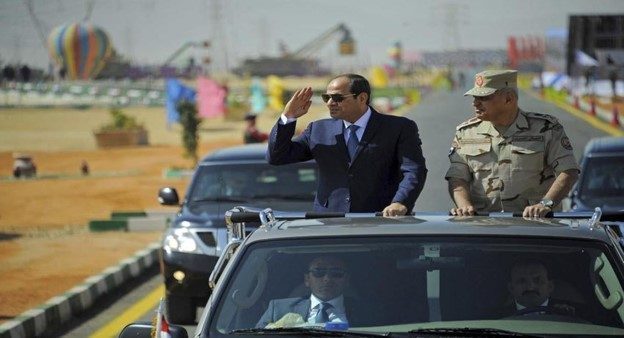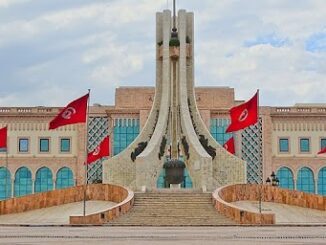
In a new Carnegie Middle East Center compilation, Yezid Sayigh argues that although Egypt government pledged to IMF to bring military companies under full financial transparency & governance, it lacks the capacity and commitment to follow through:
The public release of the Egyptian government’s draft State Ownership Policy (SOP) in June 2022 raised an immediate question: would the new framework encompass the military’s businesses and its general role in the economy? The draft mentioned neither, and so a broader question was whether the SOP could be coherent without addressing continued military involvement, since this would directly undermine the integrity—and therefore the viability—of the government’s stated goals in numerous economic sectors.
The official Memorandum of Economic and Financial Policies (MEFP) submitted by the government on November 30 as part of its new loan agreement with the International Monetary Fund (IMF), appeared to resolve these questions by placing all military businesses squarely under the same regulatory and governance framework as the rest of the (civilian) public sector. The final version of the SOP was also brought in line through the addition of a single phrase placing “companies affiliated with the Armed Forces and operating in the economic sphere” within its scope.
The implications of the MEFP are staggering. In short, the government said it would assert direct control over military companies. But that presents a problem in itself, not least because there appears to be little policy capacity or political will to implement this provision. Indeed, the military has expanded its activities in sectors that the SOP originally encompassed, and some of its most important economically active agencies are not companies at all.
Furthermore, although the MEFP incorporated the SOP as its “structural benchmark” (as did the IMF loan program), there was no attempt to adapt the sectoral priorities and modalities contained in the SOP so as to resolve contradictions between the updated commitment and the realities of continuing military involvement in the economy.
Flip-flopping on this scale within the space of a few months hardly inspires confidence. Moreover, without specifics on how the government hopes to subject a supremely powerful military to the SOP provisions, it is unclear how committed the government really is. Indeed, given its own haplessness in the face of economic agenda–setting by an all-powerful president, is the government being bold or merely disingenuous?
Either way, its policy framework leaves an irreconcilable gap between its declared goal of leveling the economic playing field with the private sector and the reality of the military’s economic role and business activities.
In labeling the SOP explicitly as its benchmark for structural reforms, the MEFP affirms the significant loopholes that allow the Egyptian state—and hence the military—to retain substantial ownership in the economy. But ownership is only part of the picture. Bringing the military under the overall regulatory and governance framework mapped out in the MEFP would help plug some significant gaps left open by the SOP.
In particular, the MEFP promises that all state-owned enterprises, including military companies, will be required to (1) submit biannual financial accounts and declare “any quasi-fiscal activities” (with data for public release); (2) adopt performance contracts for management based on formal operational and financial targets; (3) submit to more centralized oversight in each sector and to empowered anticompetitive practices; (4) undertake public procurement in a fully competitive and transparent manner; and (5) lose all their current tax exemptions.
At a minimum, good-faith implementation of these provisions could go far in curbing blatant violations and market rigging across all economic sectors and activities, including those from which the state will exit only partially or not at all. But even if the SOP and MEFP were to be implemented in tandem, the military would still have significant leeway to continue on its present trajectory. First, both policy documents make a crucial distinction between “strategic” and “nonstrategic” sectors to justify largely maintaining, and in many cases increasing, the economic footprint of the state and therefore the military as well.
As loose as it is broad, the definition of “strategic” sectors ranges from those that meet the daily needs of citizens (for example, food, education, healthcare, and energy), through low-income housing and public infrastructure, to those that involve industry technology transfers, various manufacturing areas, the media, chemical inputs for agriculture, and land reclamation.
Notably, as the state seeks to reduce its ownership in nonstrategic sectors, the military’s role in spearheading or managing state investments in strategic sectors could actually grow relative to other public agencies.
This is a significant concern, as the military is already present or a leader in the construction, provision, and support of land and maritime transport infrastructure, hospitals, and primary healthcare centers; communications, media production, and distribution; engineering industries (equipment and machinery, semiconductors, vessels and boats construction, and renewable energy); metallurgical activities; printing and advertising; pharmaceuticals and medical supplies; and fertilizers.
Second, the military is involved in prominent sectors that are not specifically mentioned in the SOP. These sectors include cement and steel (in which the military’s share of total capacity has gone from nearly zero in 2011 to around 25 percent and 16 percent respectively by 2019); the automotive industry; and intermediate (industrial) chemicals.
of the tourism sector is also striking. In December 2022, the Ministry of Military Production was awarded usufruct rights to manage the Cairo Zoo and nearby public gardens for twenty-five years, and in February 2023, the military-owned Tolip hotel chain acquired the five-star Stella di Mare resort in Sharm el-Sheikh. The military had already been awarded exclusive control over lucrative parts of the Red Sea littoral and forty-seven offshore islands in 2019.
Another glaring omission is real estate, which was mentioned in the original draft SOP but dropped in the final version. The Ministry of Defense has a 51 percent stake in the company managing construction of the New Administrative Capital, which according to Sisi had 3-4 trillion pounds (then $191 billion–$255 billion) in total holdings by August 2021 and had earned 2 trillion pounds (then some $102 billion) in revenue by October 2022.
The military moreover manages many, if not all, of the twenty-two new residential cities completed around the country by early 2021 (out of thirty planned), with investments totaling 700 billion pounds, according to Prime Minister Mostafa Madbouly. Encroaching further, the Land Projects Agency of the Egyptian Armed Forces (EAF) acquired commercial exploitation rights over much of Cairo’s public waterfront and adjacent wetlands, thirty-six midstream islands in prime urban locations along the Nile River, and Alexandria’s largest parks in the course of 2022.
Strictly speaking, so-called strategic sectors could be subjected to the same regulatory and governance frameworks as nonstrategic sectors, regardless of whether the state or private sector exercises ownership. However, the MEFP is vague on this point. It promises “specific measures to address competitive neutrality in line with the eight priority areas outlined by the Organisation for Economic Co-operation and Development (OECD), namely the operational form of government business, cost identification, rate of return requirements, public service obligations, tax neutrality, debt neutrality, regulatory neutrality, and public procurement practices.”
But the MEFP links the applicability of these measures specifically to nonstrategic sectors. The same is true of the MEFP’s monitoring and evaluation framework, which requires annual reports that include evaluations of the divestments, disclosure of the assets and parties involved, and explanations of how the divestment proceeds are used.
The preceding highlights legal and regulatory loopholes that will impede application of the SOP and MEFP to the military. For example, there is no indication that the economic activities of military companies and agencies in the civilian domain will be subject to the same contract enforcement and arbitration system as their civilian partners, subcontractors, and investors—posing a major obstacle to Sisi’s repeated attempts to float shares in military ventures through the stock exchange or sovereign wealth fund.
The fact that only around half of the seventy-five or so military companies that engage in the production of civilian goods and services are registered as public sector or public business sector companies (a distinction determined by the law under which each was established and the ministry it belongs to) presents another legal loophole: the other half come under the Ministry of Defense and therefore may not be subject to the limitations and requirements set out in the SOP and MEFP.
More importantly, the new policy framework provided by the SOP and MEFP does not apply to military entities that undertake massive government-funded public works, but which are not registered as companies. Principal among these is the EAF’s Engineering Authority, followed by the EAF’s mega-projects, works, water, and survey departments.
Together, military agencies managed approximately one-quarter of all infrastructure and housing projects between 2013 and 2018, a percentage that appears to have been maintained since then, if not increased.1 Even the Air Force is economically active: it oversees the New Delta project to reclaim 2.2 million feddans (about 2.28 million acres) of desert land, directly implementing half of the project at a cost of approximately 260 billion pounds (then some $19.1 billion, based on unit costs cited by Sisi in April 2021).
In the policy domain, the SOP and MEFP are unlikely to stem the military’s growing involvement in setting policies in key sectors such as Fourth Industrial Revolution technologies and industrial development and in directing government procurement in spheres such as industrial and medical imports.
The military moreover leverages de jure and de facto control over crucial bureaucratic nodes for financial gain, thus constraining civilian economic enterprise. For example, the military-headed National Center for Planning State Land Uses, along with the Ministry of Defense, controls access to 94 percent of Egypt’s land surface. And even when the military does not play a formal role in setting policy, its projects nonetheless bear heavily on how the government approaches foreign debt, foreign and domestic investment, and savings.
Additionally, the country’s Military Intelligence and military-staffed General Intelligence Service (which reports to the president) each maintain civilian “front” companies, while an “Officers’ Republic” of thousands of retired officers employed throughout the civilian bureaucracy engage in insider trading and predatory practices, often jointly with their active service counterparts.
For example, an exposé in December 2022 revealed extensive profiteering by military retirees and the General Intelligence Service running the Grand Egyptian Museum project, which remains unfinished despite receiving $800 million in funding from the Japan International Cooperation Agency since 2006.
Whatever its advantages in strategic sectors, the military should, in principle, divest or reduce its stake in line with the state’s plans to exit nonstrategic sectors, whether fully or partially. But there is no indication that this will happen. There are no signs so far of a lessening of the military footprint in sectors slated for the state’s full exit (including livestock importation, dairy, mining and quarrying, wholesale trade, sports facilities, renewable energy, metallurgical industry, and chemicals industries) or partial exit (including fish farming, agriculture, retail trade, leather tanning, appliances and electronics, food and beverage industries, and waste recycling).
Indeed, even a cursory review reveals major new investments in livestock breeding, the conversion of leather waste, farming, frozen poultry importation, agriculture, and gold production as of April 2023.
The military remains wedded to its economic engagement, despite repeated failures. A massive cement factory launched at a cost of $1.2 billion in 2018—its second in an over-saturated sector—has disrupted civilian markets since coming onstream, and yet operates at well below capacity. Another example is the livestock-breeding complexes it launched in 2019 at a cost of 20 billion pounds (then some $1.25 billion), which have either closed since then or operate at well below capacity, resulting in major losses.
The military similarly sank capital in an ambitious aquaculture program in which it aimed to establish fish farms at less than market cost and then sell them on for a profit; instead, the program experienced significant cost overruns—at least partly due to corruption within the closed circuit of military finances and commercial dealings—leading to losses that were ultimately borne by the state treasury. The military may continue resisting the financial and governance requirements of the MEFP so as to obscure these types of problems and failures.
Undeterred, military companies and agencies have launched new ventures since the release of the draft SOP. Some were announced prior to 2022, including establishing factories and production lines for organic fertilizer, leather tanning and dyeing chemicals, food, and industrial gelatine; setting up civilian telecoms masts; and breaking ground for a massive phosphates and nitrogen fertilizer complex.
But newer ventures include production lines and factories for medical bandages, veterinary drugs and vaccines, vehicle tires, electrical and electronic devices, LED lighting systems, solar panels, hothouses, aluminium, food cartons, igniters for electricity plants, and extraction of heavy metals from black sands. Military agencies have also launched satellite-based internet services and what is billed as the largest polyethylene plant in the Middle East and North Africa.
Full implementation of the government’s SOP commitments would significantly affect military businesses and economically active military agencies across the board.
The contribution to leveling the playing field in civilian markets between the private sector and the public sector, including the military, would be considerable—going far toward fulfilling a central IMF goal. Concrete proposals are available in the public domain that describe how the Egyptian authorities could work with the military to restructure or divest its civilian business and public management and procurement activities and how the IMF could assist with the process.
However, there is no evidence that the military anticipates slowing, let alone reversing, its expansionary trajectory. Nor is there any reason to expect either the president or government to hold the military accountable to the SOP or MEFP provisions, except where these provisions serve its interests.
For its part, the military may argue that its continuing economic and commercial activities are in compliance with the benchmark “Guidelines on Corporate Governance of State-Owned Enterprises” published by the OECD, which the SOP claims as its reference. But such an argument does not hold up when all the other OECD benchmarks are ignored. Thus, the government’s commitments regarding the future of military companies appear to be merely cosmetic.
No matter how the SOP and MEFP are construed, Egypt’s monetary and economic crisis may actually accelerate the military’s expansionary economic trajectory, in part by reinforcing the case for state intervention. Indeed, by deepening the predicament of public and private sector businesses alike, the crisis could leave the military in a comparatively stronger position, even as the country faces crippling shortages of hard currency and savings.
But if the Egyptian government interprets the SOP as exempting the military from exiting economic sectors regarded as “saturated,” this will deter private investment in them. Worse, this would perpetuate disruptive segmentation and low dynamism, not only in the economy as a whole, but also within these sectors—as Egypt has indeed witnessed in the cement and steel sectors.
At a minimum, making the MEFP the primary policy framework could reduce the award of contracts to the military for the procurement of goods and services on a no-bid basis. Similarly, it would reduce the military’s power to award contracts in the same noncompetitive way.
According to insider accounts, the military leverages this advantage to extract profit margins ranging from 5 to 30 percent of government-funded project budgets. The enactment of a unified public procurement law, as well as financial transparency, would also substantially diminish the military’s ability to poach government contracts that would otherwise have gone to civilian public or private competitors.
Last but not least, enforcing financial disclosure would not only end the transfer of state assets to the military, but also increase state revenue, allow cost-benefit analyses (enabling feasibility studies and sensible investment strategies), and reduce abusive and predatory practices (including the hiding of arrears or the charging of unreasonable fees in return for licensing civilian use of state land).
Further, ending the military’s tax and customs exemptions and its employment of conscript labor would help level the economic playing field with the private sector, and more importantly, subject the military unambiguously to civilian business law and courts in relation to all its activities in the civilian domain.
But can any remedies be attempted, let alone achieved? As former deputy prime minister Ziad Bahaeddine has noted, the government previously adopted the same modalities for increasing private sector participation, with no discernible impact. The problem is not that remedies are not known, or indeed not already on the books, but that political will and power to implement them are lacking. Even Sisi, indisputably the most powerful man in Egypt, is hostage to the military’s transactional loyalty to him.
This is evidenced by his designation on January 31, 2023, of 15,000 square kilometers (5,800 square miles) of so-called “desert land” along 3,700 kilometers (2,300 miles) of intercity roads as “strategic zones of military importance”—a phrase that automatically awards the Ministry of Defense an exclusive commercial franchise in those areas. That this designation took place a mere three weeks after the IMF released the full text of its agreement with the Egyptian government speaks volumes.
In theory, the military could recognize the value of exiting tradable sectors, but probably only to entrench its hold on nontradable assets and associated services and on its role in managing real estate and land reclamation projects around the country.
This would of course jeopardize the entirety of the government’s pitch to the IMF, Gulf allies, and international investors, but the military remains wedded to the notion that it has gained a usufruct to state-owned assets and to national resources generally.
Rather than relinquish its stake in the economy, the military is far more likely to double down—and Sisi’s repeated urgent calls on the private sector to step up its investment share in the economy (and meet his desired targets) will not do much to stop it. Even if Sisi understands this predicament, he will not force a change in military direction, as it could cost him the presidency.



